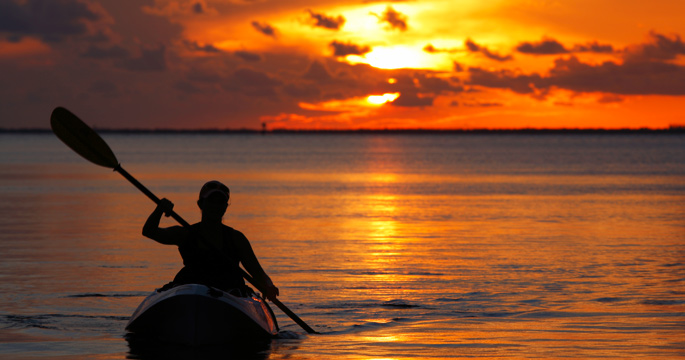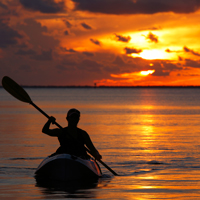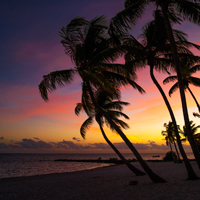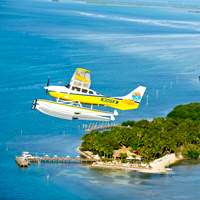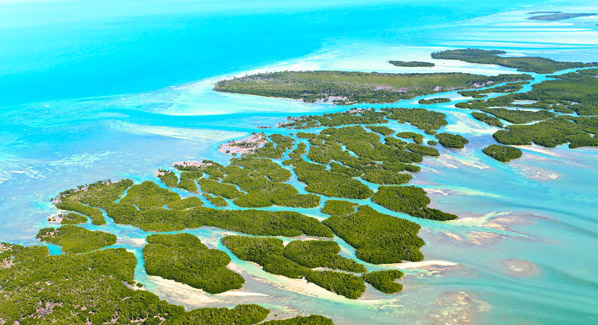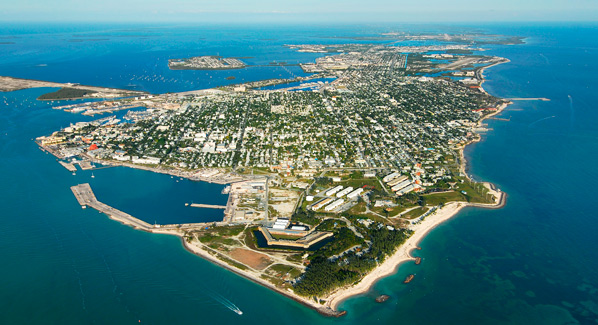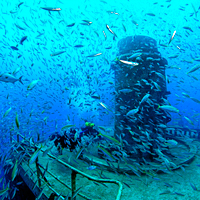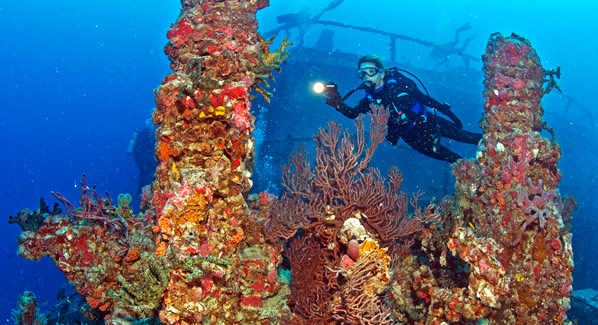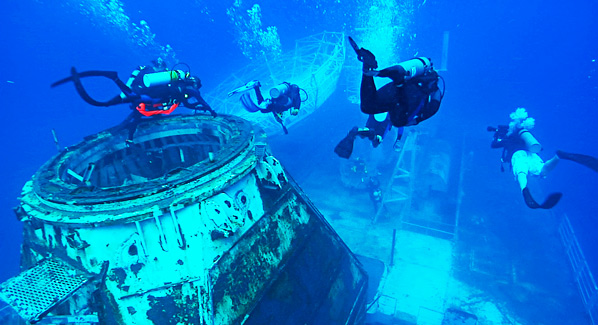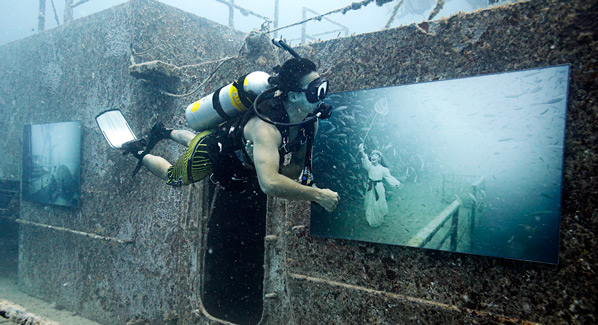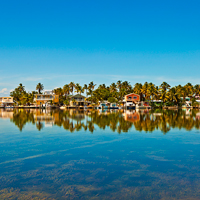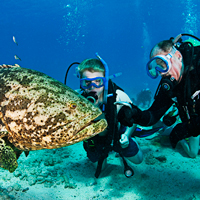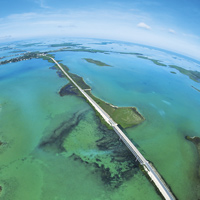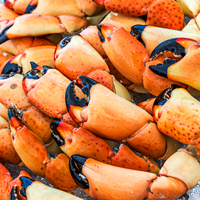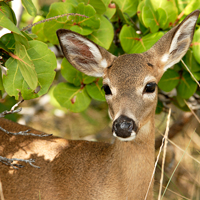Coral reefs and colorful tropical fish are what many seek when they embark on snorkeling or diving adventures. But there are bigger fish in the sea, and at select places in the Caribbean and tropical Atlantic, you can be all but guaranteed a chance to come face to face with critters that are closer to your own size—or significantly larger. Here are some of the best big animal adventures I’ve enjoyed and can endorse.
Giant Grouper
You’ll need to be comfortable performing a drift dive at depths of 60 to 80 feet for an almost-guaranteed chance to see the biggest fish on the reef. Protected status has brought the Goliath grouper back to the reefs of South Florida, where it’s sometimes possible to swim with 40 or more fish weighting 200 to 400 pounds. The annual late-summer spawn brings together the greatest number of fish, but there’s a good chance of seeing several behemoths cruising the ledges off Jupiter, Florida, at any time of the year.
Moray Eel
The teeth are wicked sharp, but that doesn’t stop Spencer Slate from hand feeding the moray eel he’s nicknamed Sundance. It’s all part of his weekly Creature Feature dives, which take place on the coral reefs near Key Largo, Florida. The big eel isn’t the only animal that comes when Spencer pulls out some tasty fish treats. There’s also a large resident grouper that shoulders in for a bite, and at least one nurse shark, destined to become the recipient of one of Spenser’s bear hugs. Next, participants in the feed are given the chance to mug with the animals themselves while the dive shop’s photo pro shoots souvenir stills and video.
Humpback Whales
Every year from January to April, pods of humpback whales pass through a region known as the Silver Banks. Located some 60 miles north of the Dominican Republic, this marine sanctuary has become a prime destination for in-water humpback encounters. Due to the long runs from shore, these interspecies meet-ups are usually staged from liveaboard dive boats. If jumping overboard isn’t for you, opt for a single- day whale-watching trip in Samana Bay.
Loggerhead Turtles
Sea turtles are among the most common large animals found on reefs throughout the Caribbean, and they are usually quite tolerant of divers and snorkelers—though it’s never a good idea to chase or harasser them. The experience turns from ooh to wow when the encounter involves a loggerhead turtle. These heavyweight hard shells can grow to 300 pounds or more, and live to a half century. A good place to find them in shallow water is among the remains of the Sugar Wreck, which is located just off Grand Bahama’s west end.
Manatee
When Florida’s coastal waters grow cool in the winter months, resident herds of sea cows move into the relatively warmer waters of spring-fed estuaries such as Crystal River on the Gulf side of the state. There, it’s possible to don mask, snorkel and a wet suit to get up close with these gentle giants. Just don’t get too aggressive or attempt to touch them, as there are strict regulations regarding interactions. This will all be explained to you during the brief ride from dock to manatee sanctuary. For more than two decades, Bird’s Underwater has remained one of the most reliable and convenient operators for manatee encounters.
Nurse Sharks
The sound of an approaching boat draws an aquatic menagerie of moochers that includes grouper, jacks, southern stingrays and nurse sharks to the sandy shallows known as Shark Ray Alley. These fish were originally conditioned to seek scraps from local fishermen, who once stopped here to clean their catch. The site is now part of the Hol Chan Marine Reserve and one of the most popular aquatic attractions in Belize. The nurse sharks, typically as benign as their name implies, sometimes seem to nuzzle up to swimmers, but what they are really after is a handout. Several operators run trips to the site from nearby Ambergris Caye.
Reef Sharks
The Bahamas offer a wide range of shark-diving adventures, some mild, some wild. The most accessible, consistent and safest are the reef shark encounters offered by Stuart Cove’s Aqua Adventures. You can don scuba to watch these impressive predators take the bait during a shark-feeding dive, observe them circling below while snorkeling the reefs, or climb into one of Stuart’s unique one-person submersibles to motor among them. The shop picks up at most of the major resorts on New Providence and Paradise Island, and caters to everyone from first-timers to movie crews who come here for guaranteed action footage.
Wild Dolphins
The meetings between human and cetacean that take place in the bright, sand-bottom shoals of the Bahamas are nothing like the encounters staged with captive animals. These are spotted pods of wild, free- swimming dolphin. When they approach, it is of their own free will, not institutional conditioning. Pods can sometimes be found in the Little Bahama Bank, but it is near the small island of Bimini that they make their most consistent appearances. Dolphin day trips can be booked with tour companies on Bimini, or for an extended adventure, there are dedicated liveaboards offering trips of up to a week.
Stingrays
Stingray feeds have spread to several islands in the Caribbean, but the original and still the most popular takes place in the waters of Grand Cayman’s North Sound. Here, dozens of tour boats are drawn to a shallow patch of sand where a resident group of stingrays has been conditioned to accept a free seafood meal. While participants kneel or stand in the shallows, the rays flit among them, getting up close to create memorable photo ops. There are actually two adjacent sites where the rays are fed, and for the best experience, avoid the large boats that ferry cruise-ship crowds and opt for one of the smaller operators.
Whale Sharks
The idea of coming face to face with a 35-foot-long shark might be alarming, were if not for the fact that these filter-feeding giants gorge on plankton, not humans. In fact, when you find yourself in the path of one of these slow-moving fish, they seem to pay you little mind as they move forward with mouths agape to suck in their tiny prey. The best place to swim with whale sharks is on the Contoy Banks, which lie north of Cancun and are best reached by boats leaving from Isla Mujeres or the more remote Holbox Island. Prime whale-spotting season begins in late May and runs into early September.

